download PDF version - To read a PDF file you need to install
Adobe Acrobat Reader: 
October 2025
Dear Clients and Friends,
Before we dive in, the IRS has just released their latest tax brackets for 2026. Here they are for your benefit:
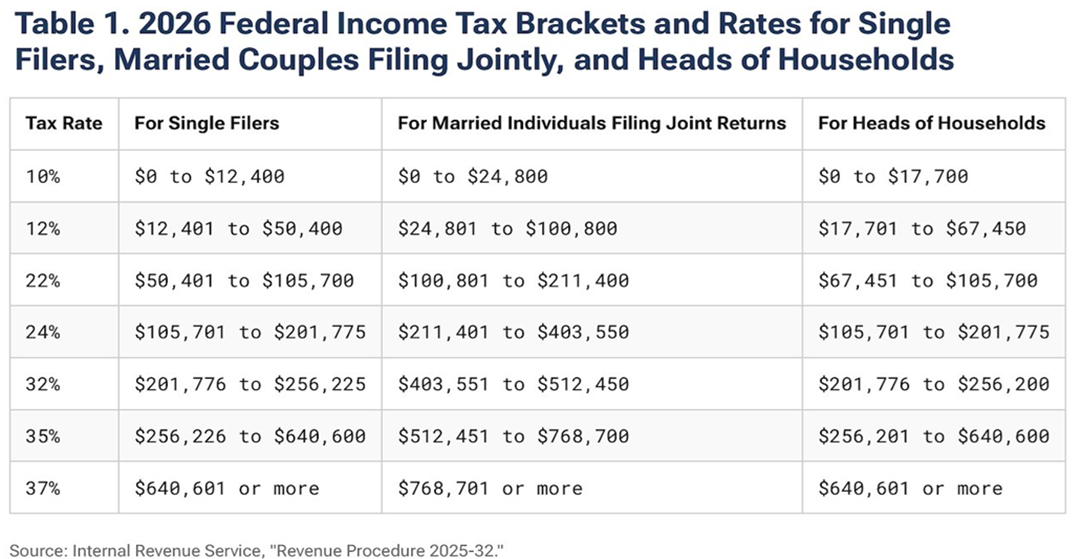
In the third quarter, investors became more comfortable with tariffs and the administration backed off some of their most onerous demands leading stocks to rebound in dramatic fashion. Nearly every major sector saw stocks rise with most international markets also doing well. Gains were bolstered by the Federal Reserve change in posture; the central bank undertaking a 0.25% rate cut in September and indicating that more rate cuts are likely at future meetings. Investors cheered despite some indications of softness in the US economy.
The economy has been posting mixed signals over the past few months. On the one hand, GDP growth has been better than expected with growth hovering above 3% and this quarter’s GDPNow forecast showing almost a +4% lift for the current quarter. AI infrastructure spending is really off the charts as the country’s massive tech companies race to build data centers in support of projected AI demand. The ripple effect of this unprecedented spending has been substantial and widespread with utilities joining semiconductors as leading market sectors. Corporate earnings, the ultimate fuel for stock prices, rose dramatically in the most recent quarter with a +12% growth rate (~80% of that increase was due to AI-related stocks).
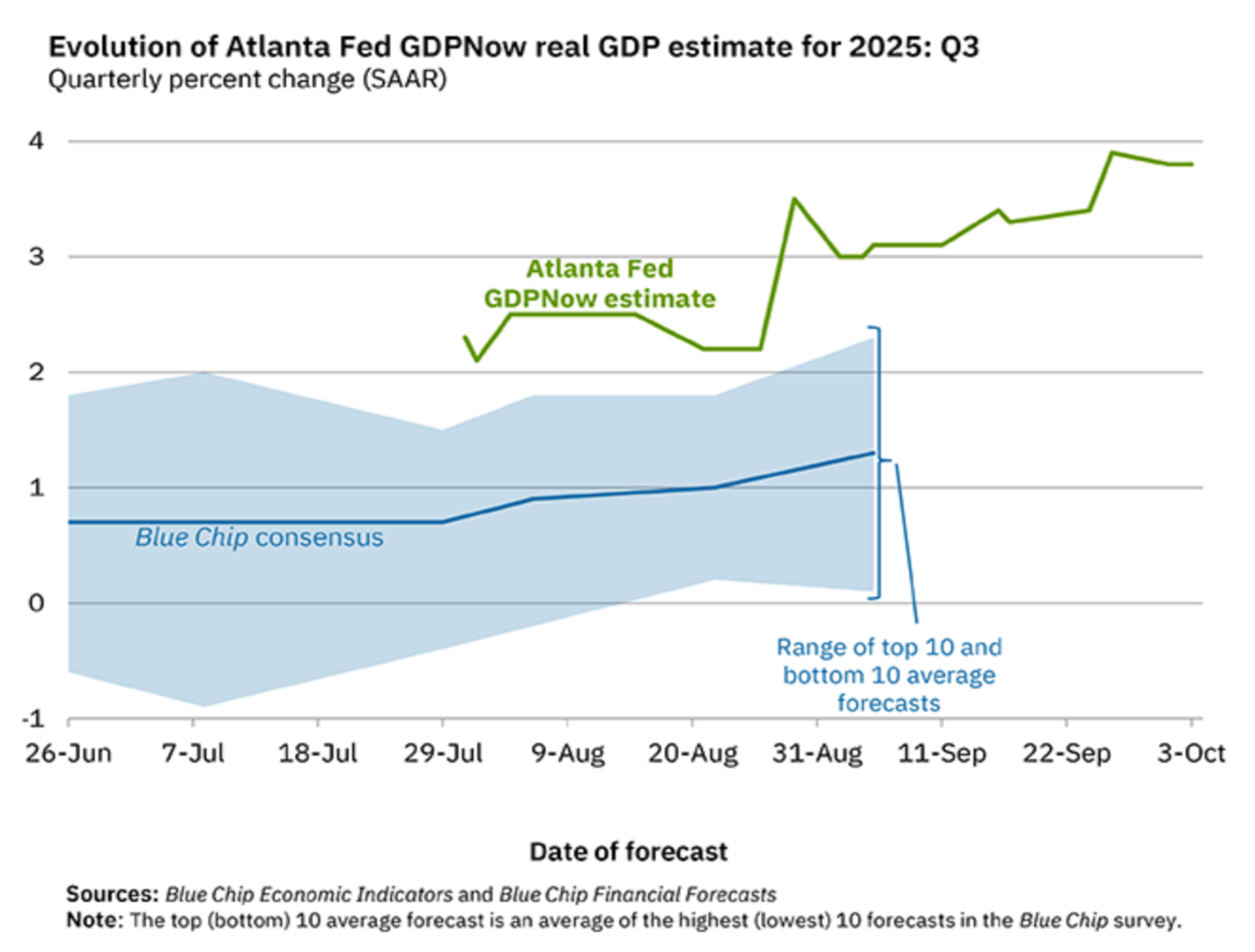
Countering the heavy AI spending has been weakness in housing (and real estate generally) alongside a slack labor market. After a time of very tight labor conditions, which contributed notably to the higher inflation, labor markets have shifted to a state of rising unemployment, flattening wage growth, and decreasing job openings. The rapid development and promise of AI-driven productivity gains have somewhat frozen hiring by many companies as they wait to see how the reality of AI will actually affect their labor needs. Recent data shows that the number of YTD new hires is tracking at the lowest rates since 2009. The chart below shows how unemployment has been ticking upward from the ultra-tight conditions of a couple of years ago.
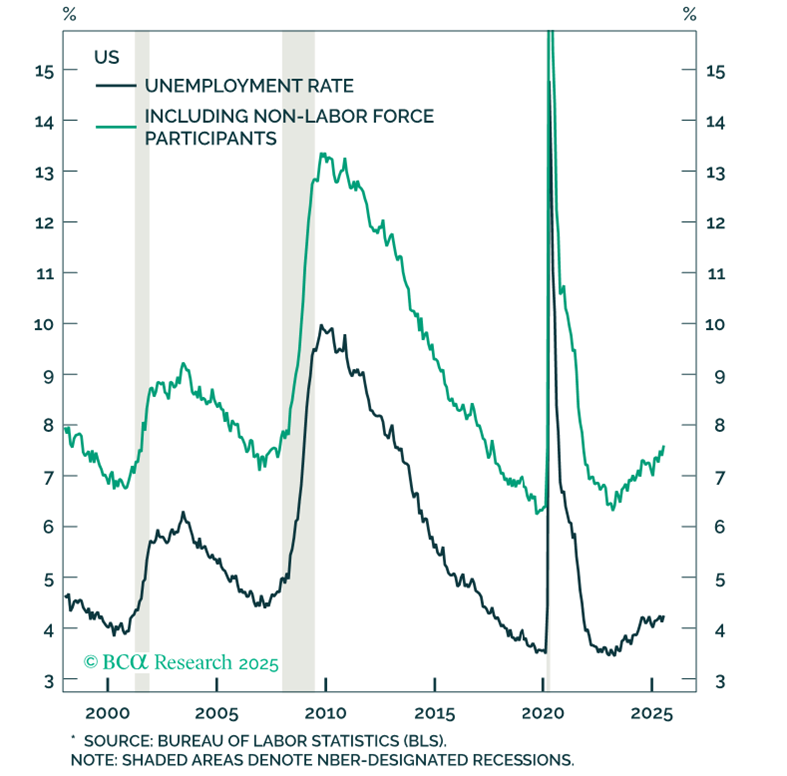
A further wind in the market’s sails has been the prospect of the Federal Reserve resuming a policy of easing interest rates. Unlike central banks in other countries, the U.S. Federal Reserve has a dual mandate of price stability PLUS labor market health. The rising unemployment, noted above, lessens inflation, in theory, as competition for job openings keeps wage growth down. However this year, the Fed has been wrestling with far more unknowns than usual. The chart below shows that inflation has come back down to around 2.5%, fairly consistent with historical averages.
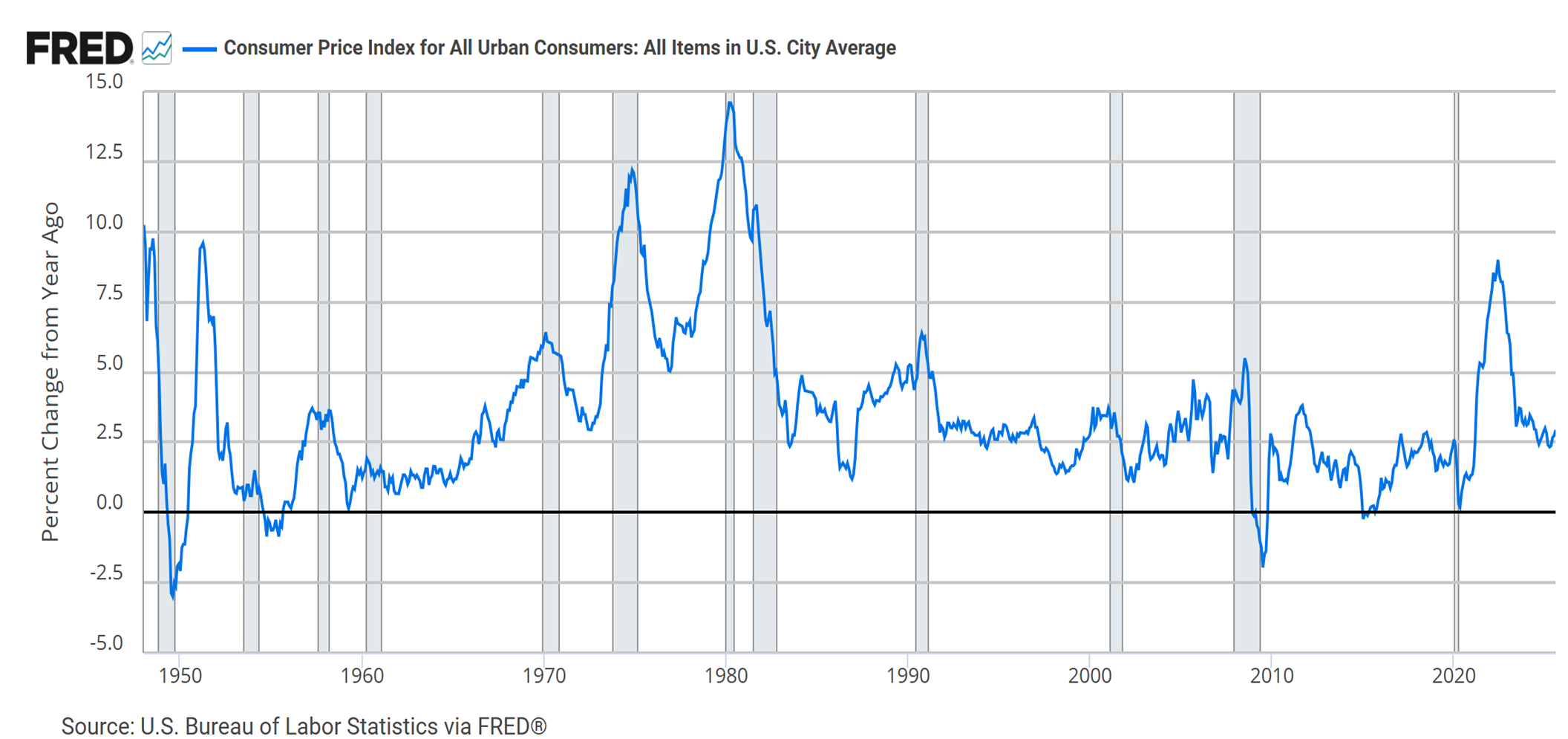
But the reduction in inflation has stalled in recent months with lots of uncertainty around the true impact of newly-imposed and broad-based tariffs. On the surface, tariffs would contribute to inflation. However, it depends on whether and to what extent companies pass along the higher cost to their customers. To this point, the impact thus far has appeared marginal. But the shift in trade policy has clearly made the Fed more cautious in pushing for lower interest rates.
Nonetheless, the Fed did cut short-term interest rates in September. And it is projected to cut rates another time or two before year-end. Rate cuts, first and foremost, encourage refinancing of existing debts at lower rates. This applies to homeowners refinancing mortgages and to businesses refinancing bank loans and corporate debt. In short, the prospect of future interest rate reductions frees up cash and encourages business activity. However, if the rate reductions are in reaction to a weakening economy, they may be too late to change the downward course. For now, as described above, the economy overall appears to be holding up fine with the prospect of rates “normalizing” to keep investment flowing rather than in response to notable economic weakness.
Another notable weakness and possible economic risk comes from housing. According to Mark Zandi, chief economist at Moody’s, declining residential building permits is the most significant predictor of recessions. As shown below, permits have been heading down for 2-3 years now. Moody’s analytical model says there is a 47% likelihood of a recession, very near the 50% tipping point reading that has, in the past, signaled a recession. Gray bars in the following chart indicate recessions.
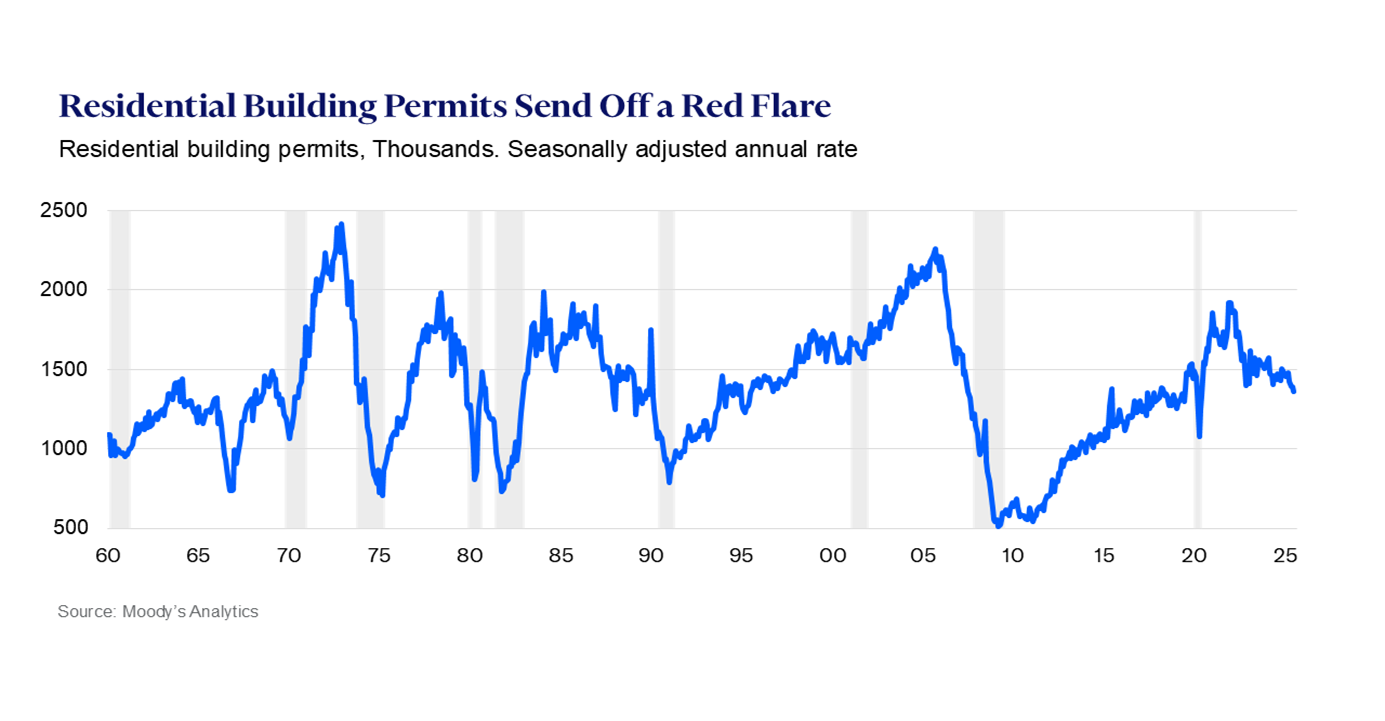
Further in the report from Moody’s, they believe that 28 states are already in a recession. The conclusion that the broader US economy is slowing dramatically was bolstered this week by Harvard economist Jason Furman who concluded that U.S. GDP has only increased at an annualized rate of 0.1% in the first half of 2025 if one excludes the build out of data centers and software for AI and cloud computing. He further notes that this spending accounted for an astounding 92% of the GDP growth during that period. Of course, it is precisely this spending that fuels the upward thrust of the Mag 7 stocks which account for the bulk of the stock market. This is why stocks can go up even if the broader economy experiences weakness.
In summary, there is no dispute that AI spending is driving the U.S. economy and pushing the stock market higher, much as the Internet and World Wide Web buildout pushed the economy and markets higher in the 1994-1999 period. Anyone investing during that time is well-aware of the subsequent bust when the NASDAQ fell 78% from its March 2000 peak until it bottomed out in 2002. There are many who point to the current environment for AI (and also quantum computing) and see similar investor behaviors and possibly unrealistic expectations. Unlike the internet buildout, however, the companies driving the AI infrastructure boom are extraordinarily profitable with mountains of cash. It seems likely that at some point there will be a repricing of the risk involved – e.g. not ALL of these companies will be big winners, and a sort of double-counting of overall demand wouldn’t be surprising. We are very aware of these concerns and the potential that the economy may be weaker than it appears on the surface. In response, we have become somewhat more conservative as the market hit record levels in September. And we are actively poised to become outright defensive if the market decides to downshift notably.
To future profits,
 Don Lansing Chief Investment Officer. 512-289-0620 |
 Garrett Beauvais Portfolio Manager 512-796-0233 |
download PDF version - To read a PDF file you need to install Adobe Acrobat Reader:

Thank you for your time and interest!
To obtain more information or to schedule a FREE personal consultation so you may fully understand the benefits our clients receive, please contact us at:
| Phone: | (512) 255-8722 |
| Email: | info@markettrendadvisors.com |
| Business hours: | Monday through Friday 8:00am to 5:00pm Central Standard Time |
MARKETTREND Advisors, Ltd.
9508 Topridge drive
Austin TX 78750
MarketTrend Advisors is an investment advisory firm that specializes in the trend-following strategies outlined in this report. We offer a variety of strategies that can be used to build portfolios to meet almost any investment objective. We divide our strategies into two main groups: "Long" strategies and "Trend" strategies. The Trend strategies follow the trend up or down. The "Long" strategies are typical investment portfolios that usually remain fully invested, potentially raising cash or moving to income-focused investments when the market is weak. We have a variety of "Long" strategies depending on how aggressive or conservative you want to be. These strategies will make their money when the market is moving higher. The "Trend" strategies will provide protection in a down market and add to gains in an up-trending market. By combining the Long and Trend strategies you get all the components needed to build a successful long-term portfolio:
- A portfolio invested in the best performing indexes, ETFs, or stocks
- Substantial exposure to global growth through international holdings
- Protection for your overall portfolio from down-trending markets When the market is going up, you benefit as aggressively as you wish.
Disclaimer
- MarketTrend Advisors, Ltd. is an independent registered in the States of California, Florida, New York and Texas.
- Other Securities Industry Affiliations or Activities. MarketTrend Advisors, is not registered as a broker or dealer, nor do we have any partners or employees who are affiliated with any broker or dealer. See Form ADV, Part II for official declarations.
- MTA portfolio strategies assume risk and no assurance is made that investors will avoid losses. No representation is made that clients will or are likely to achieve profits or incur losses comparable to those shown. Performance results are shown for illustration and discussion purposes only. The performance information has not been audited. However, the information presented is believed to be accurate and fairly presented. All performance figures in this presentation are net of management fees and commissions. Management fees are charged to actual client accounts on a monthly basis. Accounts include both taxable and non-taxable IRA accounts.
- Regarding the MTA Blend strategy: This strategy was migrated into the MTA Wealth Builder strategy and closed in December 2008.
- Regarding actual performance: Actual performance for all strategies includes all commissions as well as management fees (fees range from 1% to 2%). Actual performance statistics are based on the inception date of each strategy through the end of the last business day of the most recent month listed in the monthly performance section of this report. Starting with Q4, 2006, returns include only assets of Fidelity clients who were fully invested in their respective strategies. Returns before Q4, 2006 include all Fidelity client assets regardless of investment status. Results do not include the assets of clients at other brokerage firms.
- Regarding future performance: Past performance may not be indicative of future results. Therefore, you should not assume that the future performance of any specific investment or investment strategy will be profitable or equal to corresponding past performance levels.
- S&P 500 refers to the Standard & Poor's 500 Large-Cap Corporations Index. The index is designed to measure performance of the broad based US market and consists of 500 American companies. This index is used for comparative purposes only. (Data is taken from Yahoo! Finance.)
- MarketTrend Advisors is not liable for the usefulness, timeliness, accuracy, or suitability of any information contained in its web site or of any of its services. The user understands that the information given can and will fail to predict the direction and magnitude of market price movements and the user can lose money when using this information.

